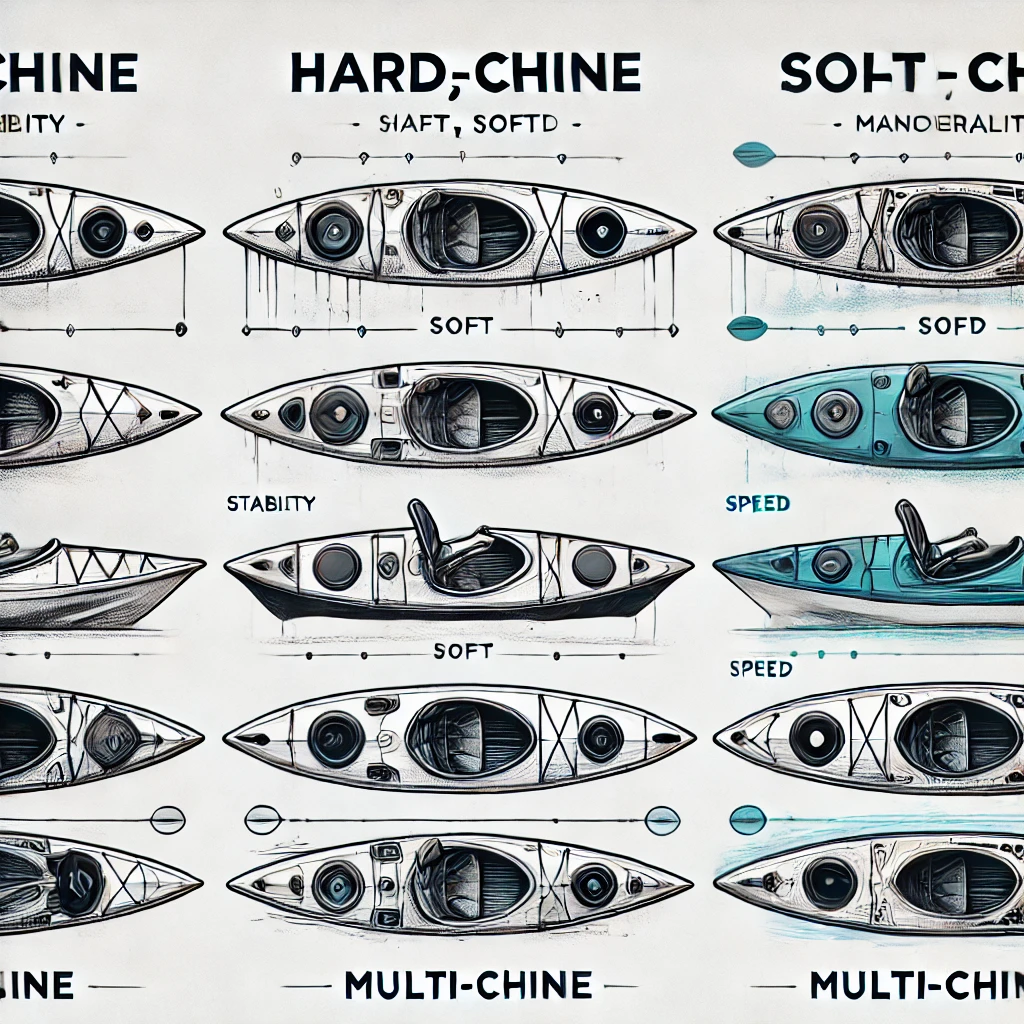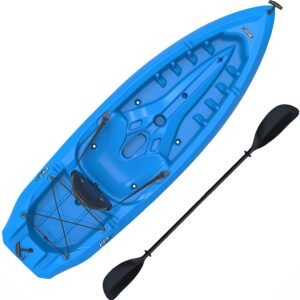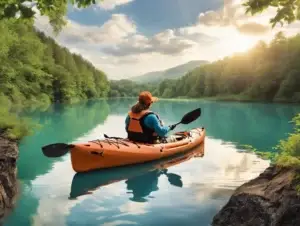The range of kayaks available may make things very confusing. If you want to find the best kayak out there, a kayak buying guide could be useful for you.
Well, we have got a comprehensive kayak buying guide prepared for you. It will be a hell of a read on which we will try to cover every type of kayaks, their most important features, as well as will describe their advantages and disadvantages.
Buckle up, and let’s get going without further ado!
Table of Contents
Our kayak buying guide
Types of kayaks
Kayaks are categorized in a variety of ways based on several criteria. There are about a dozen kayak types that we can pinpoint (and that you should know about), so there is quite a lot to learn about them.
Recreational, touring, fishing, whitewater kayaks
Based on their use, kayaks can be:
- Recreational.
- Touring.
- Fishing.
- Whitewater.
Recreational kayaks
Recreational kayaks are typically short and narrow kayaks that are suitable for kayaking in mild water. A recreational kayak would be the best kayak for you if you just want to have fun, take pictures, cover a short distance, or even do some fishing.
The shortness of recreational kayaks makes them very maneuverable. On the other hand, they don’t hold the direction well and aren’t very speedy. And due to their small size, they don’t typically have that much storage area.
Touring kayaks
Touring kayaks, sometimes also referred to as sea kayaks, are much longer than recreational kayaks. These kayaks are much faster and stable when kayaking in a straight line than recreational kayaks, but they lag behind considerably in terms of maneuverability.
Touring kayaks usually have a lot of storage space. Paired with their increased stability in a variety of water conditions, touring kayaks are suitable for those who are going to cover long distances.
Fishing kayaks
Fishing kayaks are specifically designed for fishing, as the name implies. The features valued most in fishing kayaks are stability and storage space.
Fishing kayaks are typically wider than other kayak types, though this isn’t a rule for every fishing kayak. The greater the width, the more stable the kayak is, which would allow the angler to stand on it.
Fishing kayaks also usually have several storage hatches that can be watertight. Aside from that, a common and even a necessary feature of a fishing kayak is a couple of fishing rod holders.
If you are looking for a fishing kayak, check out our review of best kayaks for fishing.
Whitewater kayaks
Whitewater kayaks are engineered to remain structurally intact when in fast-moving water. The high-impact plastic hull allows whitewater kayaks to bounce off of rocks without significant damage and leaking, though they will obviously eventually wear out.
Whitewater kayaks are mainly used in the sport of whitewater kayaking where a kayak is paddled on a moving water body like a river.
Sit-in and sit-on-top kayaks
Based on the seating of the kayaker, kayaks can be sit-in and sit-on-top:
Sit-in kayaks

In a sit-in kayak, the rider is seated inside the kayak. Such a way of seating has a number of advantages, as well as disadvantages.
Advantages
The lower body of the kayaker is protected from water splashes and wind. Because of that, sit-in kayaks are appropriate for cold water and cool, windy weather.
The cockpit could also be used for storage of your kayaking gear if there is enough free space left. For additional protection, sit-in kayaks typically allow the installation of skirts that completely close off the interior of the cockpit.
The design of a sit-in kayak provides the kayaker with a number of contact points: the kayaker can use their legs to lean onto the sides of the kayak for additional control. Some kayaks also come with padded kneepads for more comfort.
Disadvantages
On the other hand, sit-in kayaks leave little to no room for movement for the kayaker. Those with claustrophobia may even dislike the confinement of these kayaks.
Aside from that, the restricted seating position may make reaching the rear storage compartment of the kayak while on water very difficult.
One more thing. Bad things happen, and you sometimes end up being upside down in your kayak. Unlike sit-on-top kayaks, ejecting yourself from a sit-in kayak isn’t very easy, though we can’t say that it is unimaginably difficult either.
However, you should practice proper ejection before actually kayaking in a sit-in kayak so you can avoid ending up in a very stressful situation.
Sit-on-top kayaks
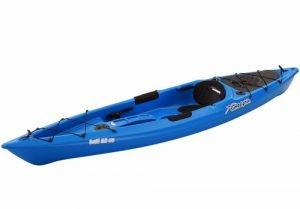
In a sit-on-top kayak, the lower body of the kayaker is out in the open, which also implies some advantages and disadvantages.
Advantages
In a sit-on-top kayak, you would have incomparably more freedom of movement than in a sit-in kayak. That’s because you aren’t restricted in place by the cockpit. This would allow you to easily move around, reach your equipment, and also eject much quicker.
Disadvantages
You don’t get as much protection from water and wind as in sit-in kayaks. This makes sit-on-top kayaks more suitable for warmer water on not too much windy days, though you could kayak on a cool day as well if you can tolerate the cold.
1-, 2-, 3-person and more kayaks
When it comes to the number of riders, kayaks can be:
- 1-person.
- 2-person/tandem.
- 3-person and more.
The most common type of kayaks you are going to see out there have one seat. Tandem kayaks are less common, but you should be able to find a good number of them. As for 3-person kayaks and above, there are only a few models on the market.
The choice of one or the other will depend on whether you want to kayak alone or not.
Paddle, pedal, motorized kayaks
Kayaks can be propelled with paddles, pedals, or motors.
Paddles
Most commonly, kayaks are propelled with just paddles. They are the simplest and cheapest way to propel and maneuver a kayak.
Unlike pedals, they do not require you to do some heavy modifications to the kayak, which makes them much, much more affordable. Aside from money, you also save much money and effort by just sticking to paddles.
On the other hand, paddles will keep your hands busy, so you won’t be able to, for example, paddle and hold a fishing rod simultaneously.
Pedals
Pedals in kayaks are used in the same way as in bicycles. You simply spin them to propel and steer the kayak.
The main advantage of kayaks with pedals – which, by the way, is favored by some anglers – is that it allows you to keep your hands free. You won’t have to stop moving to grab your fishing rod.
On the other hand, if a kayak doesn’t have all the mounts already, modifying the kayak for pedals may be very time-consuming, not to mention that it will most likely be quite costly.
Aside from that, you don’t get as much control with pedals as you would with a paddle. When you paddle, you can see where you submerge the paddle, which could allow you to avoid branches and whatnot.
That’s not the case with pedals, unfortunately, since they are out of view under the hull.
Motor
Having a motor unit installed is probably the most convenient way to do stuff on your kayak. Everything should become easier with a motor: you would be able to freely move around the kayak to say reach your bag for a snack or, again, take your fishing rod.
However, motors are considerably less cost-efficient than paddles and pedals. A motor would require fuel and frequent maintenance, which wouldn’t be the case with pedals and paddles (though they may still require maintenance from time to time).
Not to mention that you would probably need to buy a kayak motor since kayaks typically don’t come with one preinstalled. This will most likely be very expensive.
Aside from that, motors are noisy, which may be not to your taste. And the fish also probably will run away as soon as they hear the motor’s sound approaching.
Foldable and inflatable kayaks
Even those looking for compact and portable kayaks could find something for their needs. Foldable and inflatable kayaks would be great for those kayakers who need to be able to manage their storage space efficiently.
While foldable and inflatable kayaks have the same benefits in general, they have a couple of differences that could be decisive for some people.
Foldable
The hull of a foldable kayak has several seams allowing it to be folded down pretty compactly for increased storage and transport efficiency.
Foldable kayaks could be folded down to pretty small sizes. Some manufacturers also include carrying bags with them for easier transportation.
Inflatable
An inflatable kayak is much more compact when deflated than a foldable kayak. That’s because they don’t have solid frames that could limit the extent to which you could fold the kayak down.
The main downside of inflatable kayaks is that you have to inflate them with a pump. In terms of time, the inflation of an inflatable kayak probably won’t differ too much from the assembly of a foldable kayak.
However, the fact that you need to have a pump on you (which will take up some space) may be a big no for you. And if you don’t have a pump, you would need to buy it.
Hull shape
The hull shape of the kayak plays a key role in its performance, how stable it is, and how much it rocks in the water.
Primary and secondary stability
There are two types of kayak stability: primary and secondary stability. Primary stability determines the general stability of the kayak on flat water. Secondary stability refers to the steadiness of the kayak when it is tipped on its side.
Secondary stability is more important than primary stability in poor water conditions. Kayaks designed for flat water have more primary than secondary stability, and vice versa.
Kayak manufacturers often seek to find the perfect balance of primary and secondary stability for the kayak depending on its purpose.
The primary and secondary stability of the kayak depends on the shape of its sides – called chine – and the shape of its bottom – called rocker. The degree of curving strongly impacts the performance of the kayak.
Hull side shapes
Soft & hard chine
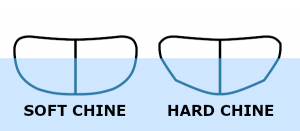
There are two general types of chine – soft and hard chine – that differ in the transition from the side of the hull to the bottom.
A soft chine is characterized by a smooth transition from the side to the bottom, which makes the side and bottom of the kayak look like a cylinder. Kayaks with soft chine are quicker and tend to have more secondary than primary stability.
On the other hand, in a kayak with a hard chine, the transition from the side to the bottom is angled rather than smooth. The angle from side to bottom sometimes is as much as a right angle.
A hard chine kayak tends to lack secondary stability and to have more primary stability. Hard chine kayaks also “grip” wave faces easier, which tends to increase the surfing performance of the kayak.
Round, V-shape, flat, and pontoon side shapes

There are four basic types of kayak hull side shapes: round, V-shape, flat, and pontoon.
Rounded hulls
Rounded hulls, as the name suggests, have rounded edges that make the kayak look like a torpedo. This shape reduces the water resistance of the hull and increases its speed.
Rounded hulls tend to make the kayaks more maneuverable and also usually have more secondary than primary stability.
V-shape hulls
V-shape hulls have a sharped V shape, allowing the kayak to cut through the water more efficiently. V-shaped hulls are usually fast and are and also better at maintaining the straightness of the course.
On the other hand, these hulls have more primary than secondary stability.
Flat hulls
Flat hulls are the most basic yet the most used type of hull sides in kayaks. Such hulls generally offer a balance between stability and maneuverability. They also excel at primary stability.
Pontoon hulls
Pontoon hulls tend to have the best stability among other hull side shapes. In fact, they combine the primary stability of flat hulls with the secondary stability of rounded hulls, which is what makes kayaks with pontoon hulls the most stable.
Pontoon hulls also usually offer good tracking but lack in speed.
Hull bottom shapes
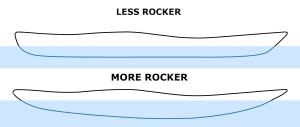
The curvature of the bottom is called rocker. Rocker can be clearly seen when looking at a kayak from the side.
A kayak with a lot of rocker will tend to rock from front to back just like a rocking chair. Because the bow and the stern tend to be partially out of the water, the bottom of the kayak will have less resistance against the water, increasing its maneuverability.
Kayaks with no rocker – basically a kayak with a flat, straight bottom – tend to be much better at tracking in straight but are worse when turning due to the increased water resistance.
Stern and bow volume
The volumes of the kayak stern and bow also strongly impact the performance of the kayak. To be more precise, it is the ratio of the volumes of the stern and bow that plays a key role.
Based on that ratio, there are three types of kayaks hull shapes: fishform, swedeform, and symmetrical.
Fishform
Kayaks with fishform hulls feature more volume in the bow and less in the stern. Simply put, the front of the kayak has more volume than the back.
The bow of a fishform hull is more buoyant and flare than the stern. This makes the entry of the bow into the water blunter and the exit slenderer. This combination makes fishform hull kayaks better at surfing.
Swedeform
In a swedeform kayak, the things are the other way around – the volume of the stern exceeds the volume of the bow. Such a shape increases the speed of the kayak, at the same time decreasing its maneuverability.
Because of the slenderer entry of the bow into the water, the acceleration of swedeform kayaks tends to be superior to that of the other types.
Symmetrical
A symmetrical hull has the same taper of the shape in both the front and back. The widest point of the kayak is at the center. Symmetrical kayaks in terms of performance will fall in between fishform and swedeform kayaks, i.e. they will have moderate maneuverability, acceleration, and speed.
Kayak materials
Kayaks are usually made from polyethylene plastic, ABS plastic, or composites.
Polyethylene
Polyethylene kayaks are the cheapest, but they also are the heaviest. They tend to be abrasion-resistant, but polyethylene plastic doesn’t withstand UV rays well, so you would need to store such a kayak in a covered place (which you should probably do anyway).
ABS plastic
ABS plastic is a bit more expensive and more lightweight than polyethylene, but the durability is about the same. It is also more resistant to UVs, though kayaks made from ABS plastic may still get damaged after prolonged exposure to them.
Composite materials
Composite materials like fiberglass or carbon fiber are the lightest and the most expensive.
Kayaks made from composite materials are considerably speedier and more maneuverable than plastic kayaks. Composites are also much more resistant to UV rays, but they are less resistant to impact.
Additional features
Weight capacity
A kayak’s weight capacity is an exceptionally important spec, especially if you plan to carry a lot of gear in it. Even if you don’t, you would still need to get a kayak that can support your bodyweight.
If a kayak doesn’t have enough weight capacity, it will sit lower in the water and will be slower. It could even sink in water if it is too overloaded.
Length
Longer kayaks cruise with more stability and also naturally have more storage space. Shorter kayaks tend to turn better.
When choosing a length, don’t chase mere inches since they won’t make that much difference. A difference of one or more feet will make much more difference.
Width
The width impacts the stability of the kayak. Wider hulls have increased primary stability but reduced speed. Things are the other way around with narrow hulls: they are faster but less stable.
Depth
A deeper kayak would have more storage space in it. Aside from that, a deep kayak would be a suitable choice for tall kayakers or for those with long legs.
Rudders and skegs
Rudders allow better steering and overall maneuverability of the kayak, while skegs increase its directional stability.
Kayaks can come with rudders, skegs, or both installed by default. Besides, some kayaks allow their installation, so you should be able to easily buy them in case you feel the need.
Seats
Kayaks almost always come with seats, but they rarely are good or comfortable enough for prolonged kayaking.
If you can’t really afford to buy a separate seat, look for a kayak that has a seat with good back support, padding, and can be adjusted back and forth.
Storage hatches
Storage hatches are a handy feature in any kayak, but much more so if the kayak is designed for touring or for fishing. A longer, wider, and deeper boat will naturally have more storage area than a smaller, narrower, and shallower one.
An important consideration with kayaks is to have watertight storage compartments, especially with sit-on-top kayaks.
Final thoughts
There you have our kayak buying guide! When it comes to specific kayak types, there still is much to be covered. We’ll do that in separate guides specifically dedicated to various kayak types, so make sure to keep an eye on our updates.
Aside from a kayak, you would need to get yourself a kayak paddle. If that’s what you are also looking for, then have a look at our kayak paddle buying guide.
And don’t forget about a life jacket! If you are going to buy one as well, read our PFD choosing guide.
